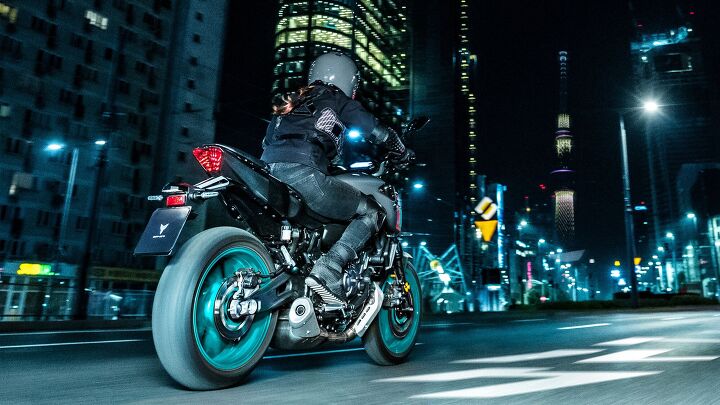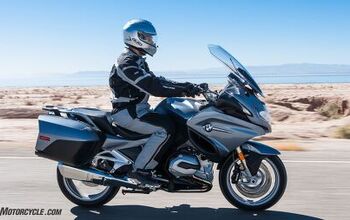City Riding for New Riders

Some days, urban transportation seems like controlled chaos. Here’s how to interface with city traffic as a beginner.
Apart from a racetrack or a rocky, off-camber clifftop trail, there may be no more demanding riding conditions than are found in a congested city. Cars, trucks, motorcycles, and (ever more frequently now) electric bicycles surround you, traffic controls including lights and signs control you, and multiple lanes (including left and right turn lanes), plus alleys and driveways demand choices. It’s basically like a Super Mario game, with you in the middle.
So, how do you handle all of this as a new rider? The primary method is by first taking an accredited rider training course or courses as required to obtain first your learner’s permit and then your full, unrestricted license. But after that, you don’t have to suddenly “go it alone” in the middle of what may seem like chaos. Here are some tips and techniques that can help inculcate you into, and help safeguard you in city traffic.
Motorcycle.com thanks Yamaha for sponsoring this new rider series.
Ride with an Expert
Small diversionary point here: In scuba diving, to get certified, you take an instructional course with bookwork and practical experience, such as in a pool. Then you make your checkout dive or dives, with an instructor observing you. Fine, you now have your certification. But – and this is important – when you book a dive trip, the boat should have a divemaster onboard, someone to oversee the location and look out for the welfare of the divers while they’re down.
Does this safety approach exist in motorcycling? It can if you make it happen. One way to do that is by riding – at least at first, while you’re getting your feet (or rather, boots) wet – with an expert. Invite them on a day ride, errands, or your everyday run to or from work or school. Follow them and soak up their practices or take the lead to demonstrate yours. It can be fun, it can be the start of a new relationship, and most importantly, it can improve both your skills and safety.
Start on the Periphery
And now, another diversion! If you’re a beginning surfer, you don’t immediately go to the local break and paddle into the crowded lineup where the waves are biggest, now do you? No, you find a smaller break, or at least paddle out to the “shoulder” of the popular spot where things are quieter, there’s less wave energy, and there’s less competition. It makes sense in the surf, and it makes sense for new riders in the city.
Let’s relate this to riding. Aside from perhaps landlocked Manhattan, there probably aren’t many cities in America that are crowded virtually everywhere. In contrast, most likely start with a few peripheral urban elements, build into busy city centers, and then sprawl outwards to quieter suburbs. These outer zones are the logical place to begin city riding. So, begin in conditions that are appropriate for your experience level, and then progress from there. It’s safer, more fun, and will hopefully leave you feeling excited and positive instead of freaked out and overwhelmed.
Ride In Quiet Hours
“Beat the Clock” used to be a popular TV show back in the early, black and white era of television. We have no idea what it was, and just on principle will resist asking Siri to find out. The show name still has relevance here, because even if you can’t change the city where you live, you can change the time of day you ride in it. No surprise, rush hour in the morning or afternoon isn’t prime transit times for a beginning rider; mid-day, evenings, and weekends will be more your style if you want to practice city riding minus the insanity.
The main roads leading into a city will likely be busiest in the morning, and roads leading out of the city will be busiest at the end of the workday. So, if you want to gain experience on these exact roads, as time permits, ride out of the city in the morning and into the city in the afternoon. This way, you’re on the same roads but going against, instead of stuck in, the snarled traffic.
Learn Situational Awareness
The military uses this term to improve tactical skills in soldiers, flyers, and others working in critical, fast-changing environments. Transferring the practice to motorcycle riding means attuning your senses to note all the relevant details to your riding environment, particularly “threats.”
For instance, you might generally notice the noise, shape, and trajectory of a bus in the next lane. But what if the same bus slowly begins merging into your lane? Not much would change in terms of its engine pitch or shape, but its movement into your space will soon comprise a critical threat. Noticing it early buys time and space to respond defensively.
In another example, an oncoming car enters a left-turn lane at an intersection as you approach from the other direction. If it stops at the limit line, its driver apparently cognizant of you and other traffic, that may constitute little threat. But if the car instead sails directly into the intersection and seems to begin its left turn, that sends a different signal entirely: You may imminently have a car strafing across your bow. Tracking the car from the moment it entered the turn lane would buy you time.
These are only two – among an endless supply – of imaginary situations that could threaten your riding day. In our experience, building situational awareness so that you sense everything, all the time, is an outstanding defensive strategy.
Practice Critical Maneuvers
If you are learning a musical instrument, or mastering how to work math formulas or equations, what do you do? Practice. Those first awkward chord progressions on your steel string aren’t easy. You’re slow at it, imprecise, and it sounds nothing like the recording you’re emulating. But with time – hundreds of repetitions possibly – your fingers know where to go automatically, the notes resonate correctly, and the sequence comes together.
There’s an old rule that it takes 10,000 hours to master a craft. That’s a lot of riding, but we’re here to say that practice does make perfect. What this means fundamentally is repeat, repeat, repeat your moves and maneuvers until, as Rooster said in Top Gun, “Don’t think. Just do.”
Become a Motorcycle.com insider. Get the latest motorcycle news first by subscribing to our newsletter here.

John L. Stein brings 30 years of both automotive and motorcycle experience, having written for AutoWeek, Car and Driver, Motor Trend, Sports Car International, Chevy Outdoors, Truck Trend, Cycle World, Motorcyclist, Adventure Travel, and Men’s Journal, just to name a few. His articles have been published in the US, England, Japan, Australia and France. His technical knowledge combined with his ability to understand and effectively communicate what a motorcycle is doing underneath him is an invaluable resource to the Motorcycle.com team.
More by John L. Stein



































Comments
Join the conversation
When are you going to write a segment on hyosung motorcycles, specifically gv650
All the metaphors are a little tiring. It adds nothing to the lesson you’re trying to teach and at the same time adds confusion. The author must’ve been paid by the word!